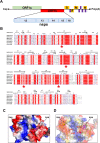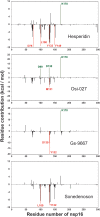Structural analysis, virtual screening and molecular simulation to identify potential inhibitors targeting 2'-O-ribose methyltransferase of SARS-CoV-2 coronavirus
- PMID: 33016237
- PMCID: PMC7544923
- DOI: 10.1080/07391102.2020.1828172
Structural analysis, virtual screening and molecular simulation to identify potential inhibitors targeting 2'-O-ribose methyltransferase of SARS-CoV-2 coronavirus
Abstract
SARS-CoV-2, an emerging coronavirus, has spread rapidly around the world, resulting in over ten million cases and more than half a million deaths as of July 1, 2020. Effective treatments and vaccines for SARS-CoV-2 infection do not currently exist. Previous studies demonstrated that nonstructural protein 16 (nsp16) of coronavirus is an S-adenosyl methionine (SAM)-dependent 2'-O-methyltransferase (2'-O-MTase) that has an important role in viral replication and prevents recognition by the host innate immune system. In the present study, we employed structural analysis, virtual screening, and molecular simulation approaches to identify clinically investigated and approved drugs which can act as promising inhibitors against nsp16 2'-O-MTase of SARS-CoV-2. Comparative analysis of primary amino acid sequences and crystal structures of seven human CoVs defined the key residues for nsp16 2-O'-MTase functions. Virtual screening and docking analysis ranked the potential inhibitors of nsp16 from more than 4,500 clinically investigated and approved drugs. Furthermore, molecular dynamics simulations were carried out on eight top candidates, including Hesperidin, Rimegepant, Gs-9667, and Sonedenoson, to calculate various structural parameters and understand the dynamic behavior of the drug-protein complexes. Our studies provided the foundation to further test and repurpose these candidate drugs experimentally and/or clinically for COVID-19 treatment.Communicated by Ramaswamy H. Sarma.
Keywords: KDKE motif; SARS-CoV-2; inhibitor; methyltransferase; molecular dynamics simulation; nsp16; virtual screening.
Conflict of interest statement
No potential conflict of interest was reported by the authors.
Figures







Similar articles
-
Computational investigation of potent inhibitors against SARS-CoV-2 2'-O-methyltransferase (nsp16): Structure-based pharmacophore modeling, molecular docking, molecular dynamics simulations and binding free energy calculations.J Mol Graph Model. 2022 Dec;117:108306. doi: 10.1016/j.jmgm.2022.108306. Epub 2022 Aug 18. J Mol Graph Model. 2022. PMID: 36063745 Free PMC article.
-
In silico validation of coumarin derivatives as potential inhibitors against Main Protease, NSP10/NSP16-Methyltransferase, Phosphatase and Endoribonuclease of SARS CoV-2.J Biomol Struct Dyn. 2021 Nov;39(18):7306-7321. doi: 10.1080/07391102.2020.1808075. Epub 2020 Aug 24. J Biomol Struct Dyn. 2021. PMID: 32835632 Free PMC article.
-
Integrated molecular and quantum mechanical approach to identify novel potent natural bioactive compound against 2'-O-methyltransferase (nsp16) of SARS-CoV-2.J Biomol Struct Dyn. 2024 Feb-Mar;42(4):1999-2012. doi: 10.1080/07391102.2023.2206287. Epub 2023 May 2. J Biomol Struct Dyn. 2024. PMID: 37129206
-
In silico molecular docking, dynamics simulation and repurposing of some VEGFR-2 inhibitors based on the SARS-CoV-2-main-protease inhibitor N3.J Biomol Struct Dyn. 2023 Nov;41(19):9267-9281. doi: 10.1080/07391102.2022.2148000. Epub 2022 Nov 18. J Biomol Struct Dyn. 2023. PMID: 36399002 Review.
-
NSP16 2'-O-MTase in Coronavirus Pathogenesis: Possible Prevention and Treatments Strategies.Viruses. 2021 Mar 24;13(4):538. doi: 10.3390/v13040538. Viruses. 2021. PMID: 33804957 Free PMC article. Review.
Cited by
-
SARS-CoV-2 Uses Nonstructural Protein 16 to Evade Restriction by IFIT1 and IFIT3.bioRxiv [Preprint]. 2022 Sep 26:2022.09.26.509529. doi: 10.1101/2022.09.26.509529. bioRxiv. 2022. Update in: J Virol. 2023 Feb 28;97(2):e0153222. doi: 10.1128/jvi.01532-22. PMID: 36203546 Free PMC article. Updated. Preprint.
-
Chemical biology and medicinal chemistry of RNA methyltransferases.Nucleic Acids Res. 2022 May 6;50(8):4216-4245. doi: 10.1093/nar/gkac224. Nucleic Acids Res. 2022. PMID: 35412633 Free PMC article.
-
Role of IFN and Complements System: Innate Immunity in SARS-CoV-2.J Inflamm Res. 2020 Sep 9;13:507-518. doi: 10.2147/JIR.S267280. eCollection 2020. J Inflamm Res. 2020. PMID: 32982366 Free PMC article. Review.
-
Aptamer BC 007 - Efficient binder of spreading-crucial SARS-CoV-2 proteins.Heliyon. 2020 Nov;6(11):e05421. doi: 10.1016/j.heliyon.2020.e05421. Epub 2020 Nov 2. Heliyon. 2020. PMID: 33163683 Free PMC article.
-
Drug Repurposing Screen for Compounds Inhibiting the Cytopathic Effect of SARS-CoV-2.Front Pharmacol. 2021 Jan 25;11:592737. doi: 10.3389/fphar.2020.592737. eCollection 2020. Front Pharmacol. 2021. PMID: 33708112 Free PMC article.
References
-
- Aggarwal, V., Tuli, H. S., Thakral, F., Singhal, P., Aggarwal, D., Srivastava, S., Pandey, A., Sak, K., Varol, M., Khan, M. A., & Sethi, G. (2020). Molecular mechanisms of action of hesperidin in cancer: Recent trends and advancements. Experimental Biology and Medicine (Maywood, N.J.).), 245(5), 486–497. 10.1177/1535370220903671 - DOI - PMC - PubMed
-
- Aouadi, W., Blanjoie, A., Vasseur, J. J., Debart, F., Canard, B., & Decroly, E. (2017). Binding of the methyl donor S-adenosyl-l-methionine to Middle East respiratory syndrome coronavirus 2'-O-methyltransferase nsp16 promotes recruitment of the allosteric activator nsp10. Journal of Virology, 91(5), e02217-16. 10.1128/JVI.02217-16 - DOI - PMC - PubMed
Publication types
MeSH terms
Substances
LinkOut - more resources
Full Text Sources
Other Literature Sources
Miscellaneous
